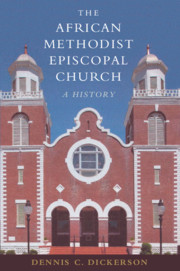Book contents
- The African Methodist Episcopal Church
- The African Methodist Episcopal Church
- Copyright page
- Dedication
- Contents
- Illustrations
- Preface
- Introduction
- 1 Richard Allen and the Rise of African Methodism in the Atlantic World, 1760–1831
- 2 The Freedom Church, 1831–1861
- 3 “Welcome to the Ransomed,” 1861–1880
- 4 A Denomination in the Diaspora, 1880–1916
- 5 Into the Second Century: Migration, Depression, and War, 1916–1945
- 6 Freedom Now! Civil Rights, Black Power, and Anticolonial Insurgencies, 1945–1976
- 7 Becoming a Global Church, 1976–2018
- Epilogue
- Appendix The Bishops of the African Methodist Episcopal Church, 1816–2018
- Bibliography
- Index
Introduction
Published online by Cambridge University Press: 20 December 2019
- The African Methodist Episcopal Church
- The African Methodist Episcopal Church
- Copyright page
- Dedication
- Contents
- Illustrations
- Preface
- Introduction
- 1 Richard Allen and the Rise of African Methodism in the Atlantic World, 1760–1831
- 2 The Freedom Church, 1831–1861
- 3 “Welcome to the Ransomed,” 1861–1880
- 4 A Denomination in the Diaspora, 1880–1916
- 5 Into the Second Century: Migration, Depression, and War, 1916–1945
- 6 Freedom Now! Civil Rights, Black Power, and Anticolonial Insurgencies, 1945–1976
- 7 Becoming a Global Church, 1976–2018
- Epilogue
- Appendix The Bishops of the African Methodist Episcopal Church, 1816–2018
- Bibliography
- Index
Summary
In 1903 W. E. B. Du Bois, hardly a denominational partisan, described “the great African Methodist Church” as “the greatest Negro organization in the world.” Only the National Baptist Convention, recently organized in 1896, exceeded the half million membership that the African Methodist Episcopalians claimed. But the Baptists, an aggregation of autonomous state conventions and local congregations, lacked the hierarchal structure of this black Methodist body. The bishops, presiding elders, pastors, and many other officials of the African Methodist Episcopal (AME) Church forged a cohesive infrastructure that proved to doubtful whites that African Americans were fully capable of effective self-governance. In addition to Du Bois’ praise for the institutional achievements of the AME Church, he was equally impressed with its longevity. Already a century old at the time of Du Bois’ comments, African Methodism had become a venerable religious body with bishops who were “among the most powerful Negro rulers in the world.” In 2004, Gayraud S. Wilmore, a Presbyterian and an African American religious intellectual, confirmed Du Bois’ descriptions of the AME Church and called it “America’s premier … predominantly black denomination.”1
- Type
- Chapter
- Information
- The African Methodist Episcopal ChurchA History, pp. 1 - 16Publisher: Cambridge University PressPrint publication year: 2020



